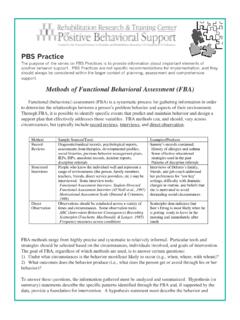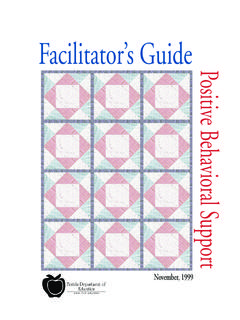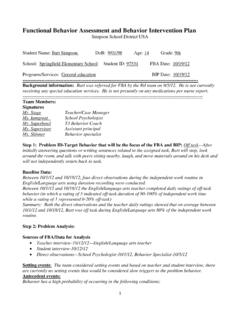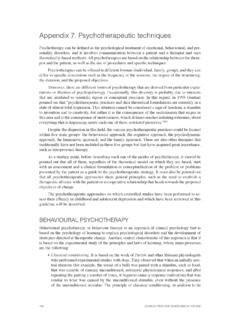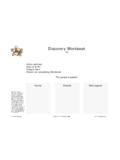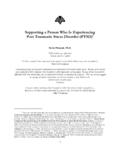Transcription of PBS Practice Positive Consequence Strategies
1 PBS PracticePositive Consequence StrategiesBehavior may be interpreted as functional (often communicative), purposeful, and meaning-ful to an individual. In other words, people engage in problem behavior because they either get some-thing or avoid something as a result. By manipulating consequences it may be possible to influence aperson s motivation, and change long-standing behavior interventions involve managing consequences so that reinforcement is given for desiredbehavior ( , use of replacement skills) and withheld in response to problem behavior.
2 This makesproblem behavior less effective than Positive behavior for the person. Positive Consequence strategiesare based on a functional assessment and incorporate the most natural, least intrusive consequences thatadequately address the behavior. Types of reinforcement include social interaction, activities, sensoryoutcomes, tangible rewards, and opportunities to escape uncomfortable order to be effective, reinforcement must compete with the outcomes achieved through the prob-lem behavior. Some considerations include the reinforcement schedule (frequency of rewards), magni-tude (amount or intensity), and immediacy (delay between behavior and rewards).
3 For example, if aExamples: HypothesesConsequence StrategiesWhen an adult's attention is withdrawn orfocused on other children, Lisa makesnoises; her behavior results in the adulttalking to her and moving closer to attention whenever Lisa asks forit appropriately, even if just to say " I'll bethere in a minute." Ignore all extend wait periods and rewardLisa for waiting unanticipated changes in theroutine occur, Ben throws his materials;having to pick them up delays thetransition to the next promptly when Ben asks forclarification regarding schedule him for using relaxationstrategies.
4 Have him pick up his materialsafter he finishes the next Donna finishes an activity early,she bites her fingernails and cuticles; thisgives her another form of sure that Donna is provided some-thing else to do when she asks and/orthat the necessary materials are purpose of the series on PBS practices is to provide information about important elements ofpositive behavior support. PBS practices are not specific recommendations for implementation, and theyshould always be considered within the larger context of planning, assessment and to reproduce this document is granted.
5 Please acknowledge theRehabilitation Research and Training Center on Positive Behavioral Support in any have heard criticisms of reinforcement programs because they are contrived. How would yourespond to this? This can be a legitimate concern. Therefore, to the greatest extent possible, reinforcersshould be natural, rather than contrived. For example, smiles and Positive comments from a friendwould generally be seen as more natural than carrying a point card or receiving M&M s every twominutes. When selecting reinforcers, it is also important to remember that the most effective conse-quences utilize outcomes that are currently maintaining behavior ( , problem behavior is motivated byescaping difficult tasks reinforcement involves breaks from work).
6 2. It sounds like Positive reinforcement simply involves giving a person whatever they want wheneverthey want it. Will this go on forever? Initially it is important to reward all Positive ( , replacement)behaviors immediately and consistently. However, eventually people need to learn to tolerate periods ofdelay and less consistent schedules of reinforcement. Behavioral support plans should include methodsto gradually thin reinforcement and shift to more natural PBS ever condone the use of punishment to address behavior? Withholding reinforcement forproblem behavior ( , extinction) is technically an example of punishment.
7 Proponents of PBS ac-knowledge that controlling access to reinforce-ment is necessary when trying to change behavior. WhatPBS does not condone is the use of aversive ( , demeaning, painful) procedures to suppress approaches have been demonstrated to be ineffective in producing durable changes in people sbehavior and do not improve to quality of their ResourcesCarr, , Robinson, S. & Palumbo, (1990). The wrong issue: Aversive versus nonaversivetreatment. The right issue: Functional versus nonfunctional treatment. In A. Repp & N. Singh(Eds.), Perspectives on the use of nonaversive and aversive interventions for persons with develop-mental disabilities (pp.)
8 381-401). Sycamore: Sycamore , , Vollmer, , Zarcone, , & Rodgers, (1993). Treatment classification basedon behavioral function. In R. Van Houton & S. Axelrod (Eds.), Behavior analysis and treatment ( ). New York: Plenum Consequence Strategiesproblem behavior typically results in a rapid, highly emotional response from others, reinforcement forpositive behavior must result in a similar or more intense response. In addition, situational variablessuch as the person s current level of deprivation ( , hunger, recent access to reinforcement) can alsoaffect the effectiveness of a reward.
